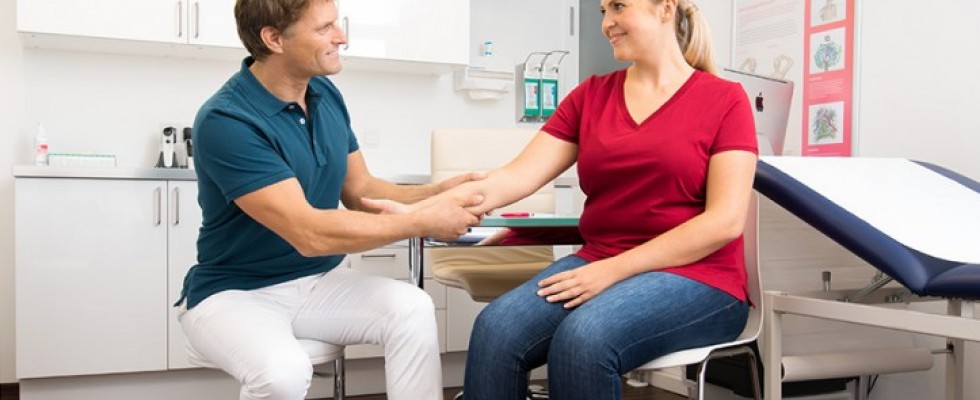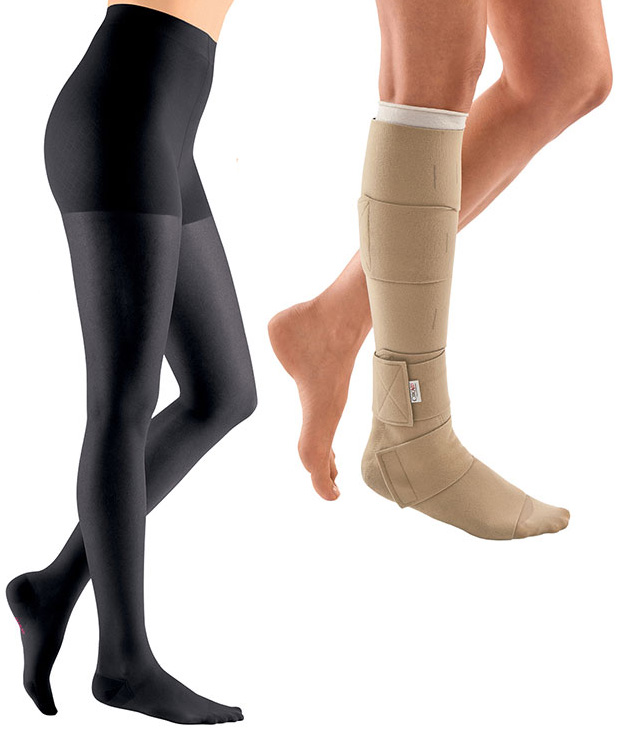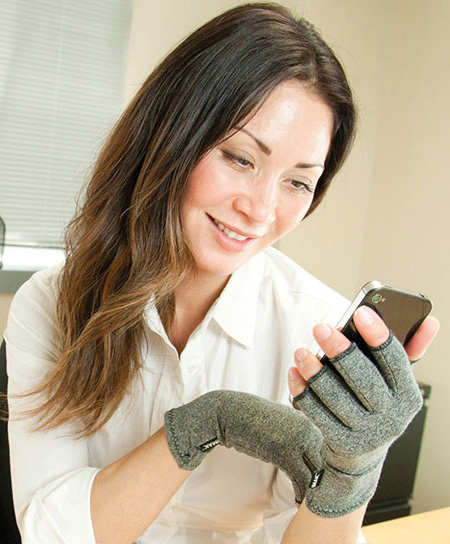
Why Compression?
Chronic venous disease (CVD) affects more than 10 million men and more than 20 million women in the United States, with some 8 percent experiencing advanced CVD with skin changes and ulceration.
Health care professionals make it their goal to prevent skin changes and dangerous ulcers by applying treatments that address edema (swelling) and the body’s natural process of releasing fluids, and that help redirect blood flow back toward the heart.
“With edema, fluid from our body goes into the tissue and stays there. It does not go through the normal vascular system back to the heart to be eventually eliminated by the kidneys. The legs and feet are the most common areas of the body where we see swelling, but we occasionally see it in other parts of the body,” says specialist Kathy Tavernelli, CNP, CWOCN, coordinator APN/PA at Cleveland Clinic’s Center for Connected Care, which provides a set of clinical programs designed to help patients with their post-hospital needs.
Edema can be the result of heart or kidney disease and other serious conditions that discourage healthy vein function, also known as venous insufficiency.
A comprehensive health assessment is conducted by a health care provider, which involves questions related to the patient’s occupation (excessive standing or sitting); weight (overweight); activity level (including the frequency of basic walking around); medical history; past surgeries; and cancer diagnosis. This health history will guide a health care provider in determining the causes of edema and best treatment options available.
“Edema of the legs is not normal and is a sign of a problem that needs to be corrected,” Tavernelli says. “Edema that is not treated can lead to pain and open wounds on the legs that ultimately diminish quality of life and increase health risks.”
Getting and keeping swelling under control is priority one, but the treatment faces obstacles—patient acceptance, causes of the edema, open wounds, lack of hand dexterity and strength to apply compression wraps or stockings, and overall discomfort from the compression. “Lack of physical activity also works against treatment success,” says Tavernelli, who works with patients in their homes as part of the Cleveland Clinic’s Connected Care program.
Many develop signs and symptoms of CVD, including spider veins, varicose veins, heavy and swollen legs and in some cases, venous leg ulcers that are chronic and hard to heal wounds in the lower legs. Compression in its many forms is the standard therapy for treating venous issues.
How Does Compression Therapy Work?
Compression therapy works by mechanically putting pressure on the veins of the legs. “It’s forcing the vein to work properly and, by working properly, that means pushing the fluid out of the legs, to the heart, and then eliminated by the kidneys,” Tavernelli says. This therapy is widely used to control swelling related to venous insufficiency.
Tavernelli cautions to keep the health care provider or nurse in the loop about compression products, should a person purchase products on their own. “If you are not using them correctly, you can increase your swelling, which leads to pain. It can have almost a tourniquet effect, causing a lot of issues and more swelling from using the incorrect size. Be sure you need it.” Proper sizing is essential, she adds.
 medi USA circaid
medi USA circaid“Compression is now a household word thanks to Under Armour and other athletic brands,” says Glenn Anderson of medi USA. “However, there can be confusion since compression products range from prescription therapy products to ordinary orthopedic softgoods people can use on their own.”
About Compression
Compression products range from prescription therapy products to ordinary orthopedic soft goods that people can use on their own.
Medical compression is measured in mmHg (millimeters of mercury) to deliver the desired dose of compression based upon a patient’s needs. When working with venous conditions, compression therapy can be delivered via bandaging (single or multi-layer), inelastic wraps or traditional compression stockings often sold at various levels of mmHg such as 15-20, 20-30 or 30-40 for more severe conditions. A more advanced form of compression therapy is intermittent pneumatic compression.
The terms compression and compression therapy are commonly interchanged.
What Affects Success of the Products?
The use of compression products and treatment success depends on many factors including a person’s ability to tolerate the compression, cost of the compression stockings, the ability to have good finger dexterity to apply the product, the ability to use products such as sock aides or specialized rubber gloves to apply stockings, as well as willing and able caregivers and HME staff to help train or, in the case of caregivers, assist with the application of the products.
“Compression is like contact lenses” says Glenn Anderson of medi USA. “It takes 10 minutes of training to stick your finger in your eye. Putting on compression is no different. That 10 minutes can change a patient’s life.”
While the FDA strictly regulates and monitors the manufacture of compression wear, it does not require a prescription for purchase. Anyone can walk into an HME compression wear provider and purchase any compression level they want. As evidence, simply look at the single fastest-growing outlet for compression wear: the internet.
In the simplest use, gentle compression is widely considered helpful for the discomforts of varicose veins, tired, achy and swollen feet, legs and ankles, and for use in athletics.
 Brownmed’s Imak Gloves
Brownmed’s Imak Gloves“Compression products have many benefits, mostly stemming from increased circulation at the site. This increased circulation warms aching joints and has been shown to help with joint flexibility and muscle stiffness,” says Matt Garver of Brownmed, a family-owned manufacturer of orthopedic products.
“Compression may also help reduce swelling and relieve arthritis pain. Today, arthritis strikes more than 52.5 million Americans, which is more than one in every five adults.”
Brownmed’s arthritis care products are marketed under the IMAK Compression brand. They are promoted as helpful for people living with chronic pain from arthritis, fibromyalgia, overuse and other conditions.
The greatest factor in this product category growth is demographics—the aging population of baby boomers, says Linda Lavi of Alex Orthopedic. Alex Orthopedic specializes in orthopedics, canes, compression hosiery, pillows and cushions. “Our compression line treats a range of conditions, from minor swelling and varicosities to chronic insufficiency and stasis ulcers.”
 Alex Orthopedic Hosiery
Alex Orthopedic HosieryBandaging, whether it is lymphedema or for a venous leg ulcer is time-consuming, uncomfortable for a patient, and expensive, as bandages are often replaced due to soiling or destruction via removal with scissors, Anderson says. "A one-time purchase product that is intuitive to apply and easy to transfer from the clinical setting to home enables self-care and self-management of the condition. The patient is transformed into a participant in their therapy on a daily basis, not just when they are in the clinic or with a clinician.”
What trends ave you identified for compression products?
Garver, BROWNMED: “Recently, we’ve seen a trend toward repeat buyers and single buyers ordering higher quantities of product. This is particularly true for consumers dealing with chronic pain conditions like arthritis. Instead of buying one pair of gloves, these customers are looking to order multiple pairs at a time, and put them in rotation, so they can wear one pair of gloves on a daily basis.”
Lavi, ALEX ORTHOPEDIC: “The shift to retail has decentralized product availability into more outlets with larger category offerings. There is a definite trend toward lower compressions and value-priced products. There is also a move toward more fashionable products for younger people and a move toward more sports-related products.”
Anderson, MEDI USA: "Enabling self-management of the patient’s condition is a key to success. Reduced visits to therapists and reduced time in the clinic is the current insurance trend so anything we do that enables self-management and efficient in homecare is a win for everyone involved. Our circaid line excels in meeting that need."
How can HME providers realize profitability?
Garver, BROWNMED: “HME providers can take steps to realize profitability by focusing on strategies that increase consumer loyalty. One way to do that is by providing an array of quality products that deliver long-term value, and by pushing customers toward those products that have the highest consumer ratings in the market.”
Lavi, ALEX ORTHOPEDIC: “The way to improve profitability in this category is to correctly balance inventory to the customer base and not overstock a significant amount of slow-moving inventory. Our pricing and the fact that we are not sold in mass merchandisers or national chains set us apart.”
Anderson, MEDI USA: "Compression remains the gold standard for managing venous issues, lymphatic conditions and chronic wounds. Lymphedema has no cure. Managing the condition is a lifelong commitment, and the HME that provides service, support and quality products has a customer for life."
Points of Interest
- Increasing prevalence of chronic venous disorders
- Growing sports and adventure related injuries
- Increasing incidence of diabetes
- Compression bandages and stockings dominate segment
